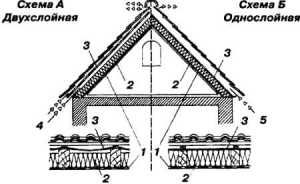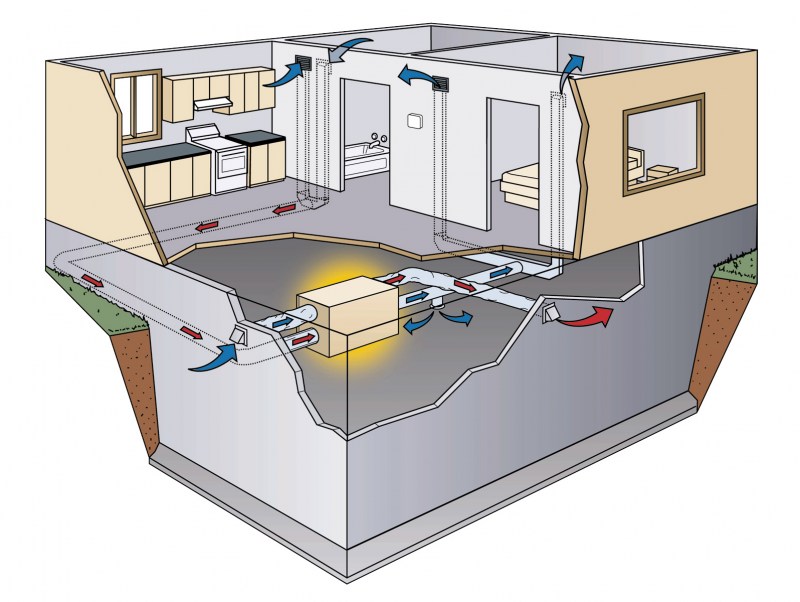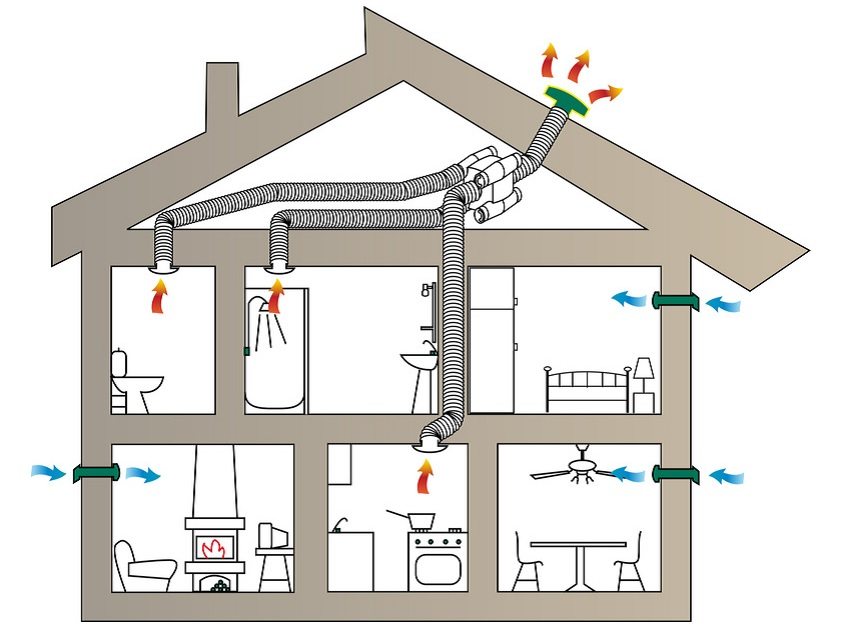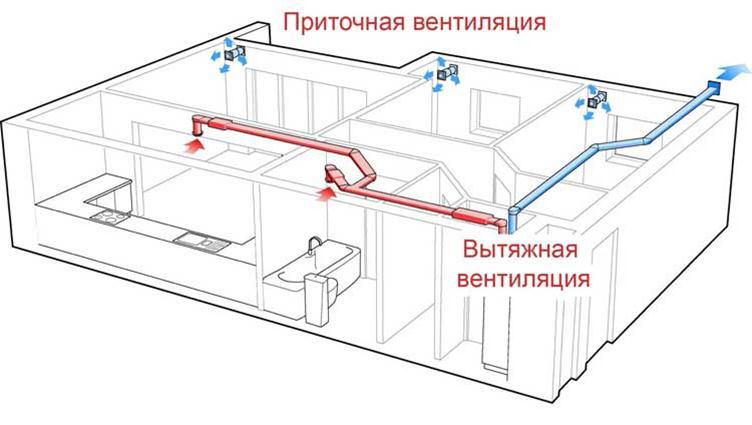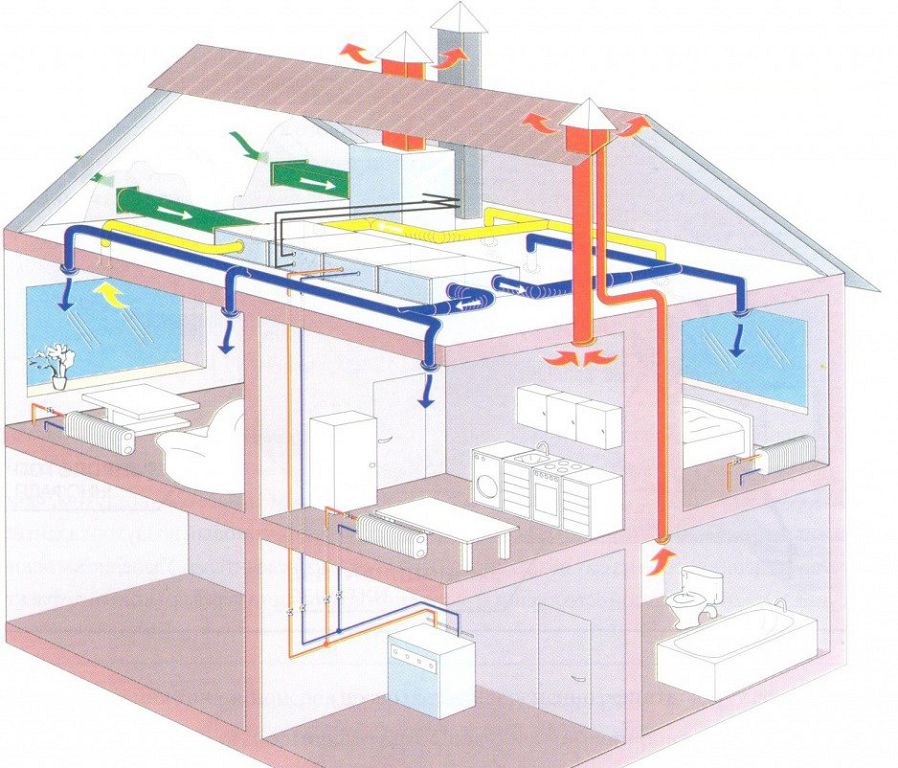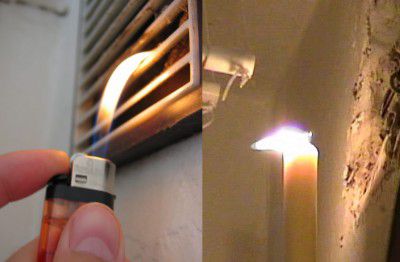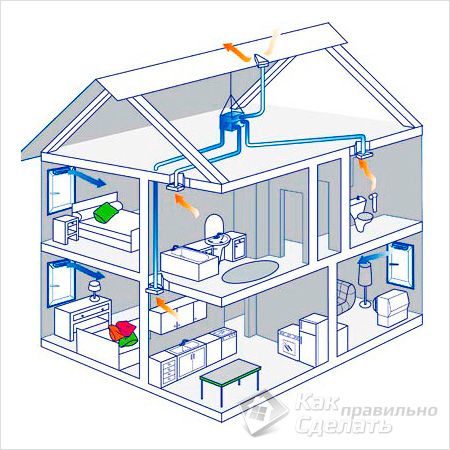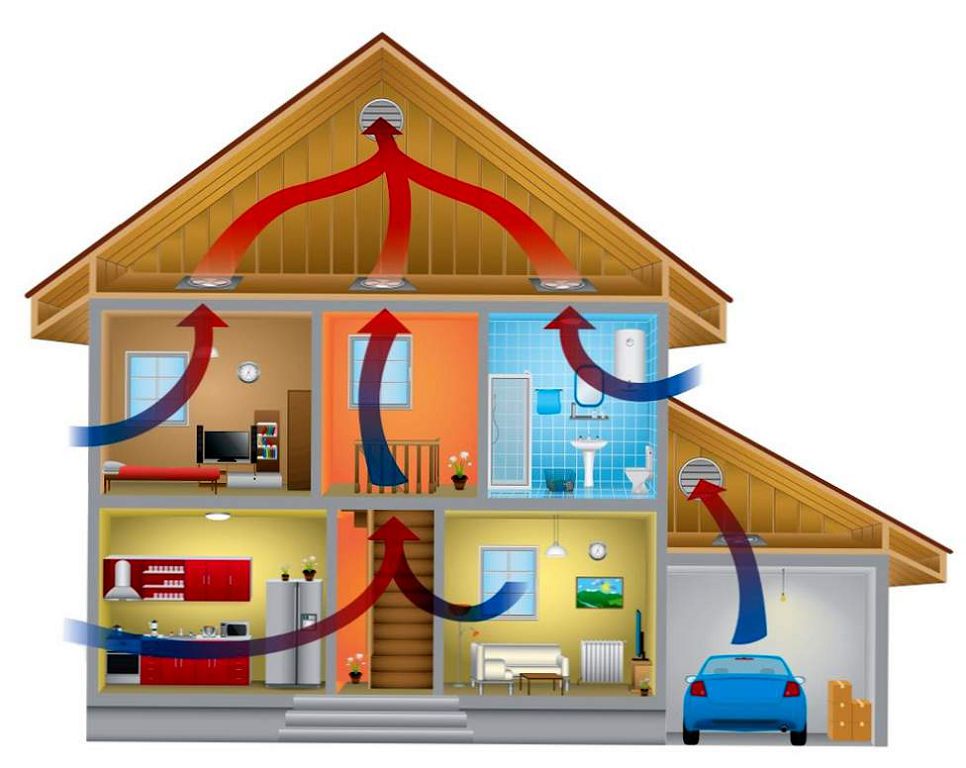The presence of ventilation in the attic depends not only on the comfort of its inhabitants, but also on the durability of the building. Moreover, ventilation is required for both the living space and the roof. We will tell you about why such enhanced air exchange is necessary and how to ensure it.
Why ventilation in the attic
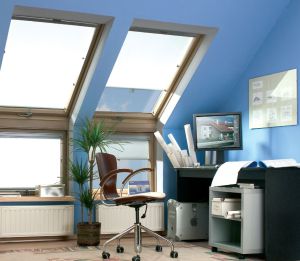
It will be impossible to fully use the space of the living attic, called the attic, without a well-designed air exchange. The living space should be provided with fresh air, at the same time it is necessary to remove the exhaust.
In the process of human life, moisture is constantly released: with breathing, during cooking, washing dishes and washing. According to the laws of physics, warm and humid air rises to the ceiling of the attic. He “looks for” the smallest cracks and penetrates further: behind the hem, into the insulation. Here, some of the moisture settles. Insulation - mineral wool, perfectly absorbs water both directly and from saturated water vapor and fog. Wet insulation practically does not fulfill its function. The rest of the steam rises even higher - to the roofing material and here it settles in the form of condensate, which causes corrosion and destruction of the roof.
And even if the attic is non-residential, it is necessary to ventilate it, otherwise microbes and fungal spores develop in stagnant air, the humidity of the room is not regulated. Often, faced with the mass of inconveniences of living in an unventilated space, the owners think about how to make ventilation in the attic.
Ventilation of the attic floor is needed even if it communicates with the lower floor by an open staircase. A separate ventilation system is required for each level of the house.
Attic ventilation functions
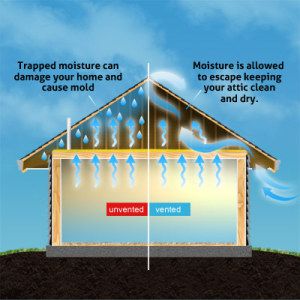
In order for residents not to suffocate from stuffiness in summer, and not to suffer from excessive humidity and cold in winter, ventilation of the attic roofing system is required.
- The task of ventilation of the attic roof is to prevent the accumulation of moisture in the roofing cake. The insulating layer remains dry, that is, all its insulating qualities are preserved;
- In a ventilated space, mold and mildew do not colonize, destroying wooden rafters and battens;
- Good air exchange under the roofing material does not allow it to heat up even under a very hot sun;
- With constant air movement, condensate does not accumulate on the roof, which quickly destroys the metal tile. For ceramic tiles, constant contact with water is also bad: soaked in water, it can burst during frost;
- With good ventilation, the attic cornice will not be covered with icicles;
- Air exchange in the under-roof space ensures uniform melting of snow on the roof, preventing the formation of ice;
- Costs for space heating in winter and cooling in summer are reduced.
Attic floor ventilation
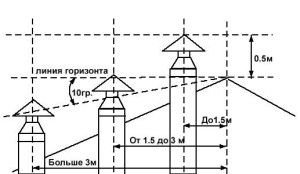
In the living room of the attic, you need to equip both the inflow and outflow of air as well as on any other floor of the house. To supply fresh air to the room, roof windows or special valves can be used. The area of the supply valves, according to building codes, should be 1 \ 500 of the area of the room.
The removal of warm and humid air from the bathroom or the bathroom is organized by means of ventilation ducts. And air exchange in living rooms will be carried out through the ventilation ducts of the kitchen, toilet and bathroom.
Ventilation ducts pass through the roof and are installed according to our proposed scheme. The exits of the pipes are covered with umbrellas so that atmospheric precipitation does not penetrate inside (or small birds do not nest in them).
Unfortunately, the natural ventilation method is highly dependent on the weather outside. In winter, it can pull very strongly, but in summer it can not pull at all. Sometimes reverse thrust occurs, which is even worse. These disadvantages are absent with forced air exchange.
There are options for equipping attic ventilation with your own hands using mechanical traction. The ventilation ducts are combined into one. It is displayed through the pediment or through the roof to the street. The draft in it will be provided by one common fan, the power of which should be calculated depending on the area of the attic. The fan must be constantly on, which is not very convenient and rather expensive.
Mansard roof ventilation
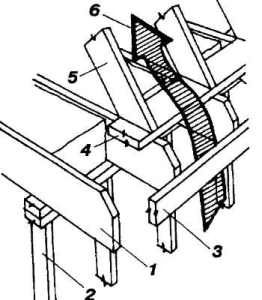
Ventilation of the roof of the attic floor is carried out by the natural movement of air flows under the roofing material. The direction of movement is from the bottom (from the cornices) to the top (to the ridge). Sometimes for effective ventilation, only competent roof assembly is enough, sometimes you have to resort to additional devices.
Ventilation of the attic roofing cake is ensured by the correct alternation of layers and the creation of ventilation gaps.
Here:
- overlapped.
- frame of the building.
- cornice.
- Plantar board.
- rafter system.
- direction of air movement.
The roofing cake consists of the following layers (viewed from below, from the attic room):
- ceiling sheathing;
- a vapor barrier film, which is stuffed onto the rafters and reinforced with slats on the underside. The vapor barrier serves to conserve heat in the room, protects the insulation from moisture. About 5 cm is left between the cladding and the vapor barrier, and the film is adjacent to the insulation;
- insulation - most often it is mineral wool, fits in the gaps between the rafter beams;
- lathing and counter-lathing - these two layers form the very gap for the free passage of air in the roofing cake. If the thickness of the rafters is small, it is increased by additional bars;
- waterproofing film. It has a micro-perforated structure: vapors coming from the room are passed into the ventilation space, and moisture cannot penetrate from above. Wetting of wooden structures is prevented. Therefore, experts recommend combining insulation and waterproofing. Read more about this in the video on attic ventilation at the end of the article;
- roofing material. A gap is also left between the waterproofing and the roofing material for ventilation of the attic roof.
It is also important to leave an air outlet at the top of the ridge. For this, use additional accessories.
Additional attic ventilation devices
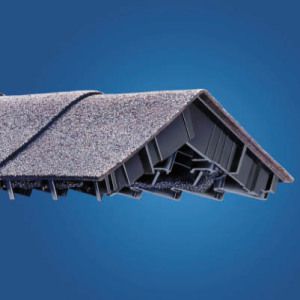
The air outlet at the ridge is provided by a ridge aerator. It is installed on the top edge of the roof instead of a ridge along the entire length. To prevent debris, insects, tree foliage from entering the aerator slots, they are covered with gratings. The combination of a ridge aerator and eaves ventilation perfectly ventilates the under-roof space.
Closing the eaves, you also need to take care of the air slots. Boards are nailed with gaps. But plastic or metal soffits with punched holes have a simpler and more aesthetic appearance.
If you need to do-it-yourself ventilation of the attic of an already finished house, ventilation grilles are installed in the eaves. They are sold in hardware stores, produced in different colors and small sizes.In the closed cornice, holes are cut out for the gratings, which are fastened with self-tapping screws.
It is more difficult to equip the upper air vents in the already finished roof: the ridge is already closed. And in this case, there is a way out: these are roof aerators.
A roof aerator is a plastic pipe with an umbrella at the top. Aerators can even be installed on completely finished roofs. Reinforced version of the aerator - a deflector, also known as a fan, which creates a reduced pressure. It removes vapors and moisture very effectively, which is very important for residential attics.
About the amount of roof airflow
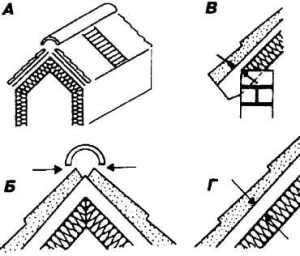
Some builders believe that the area of the air is a constant figure. This is a serious mistake that leads to ineffective ventilation of the roof of the attic floor.
The size and number of vents depend on the area and geometry of the roof.
The total area of the air must be at least 200 sq. centimeters per square meter. This is an approximate figure that needs to be clarified in each individual case. Attempts to install attic ventilation based on video or other materials can be successful, but professional advice will come in handy.
More precisely, the area of the vents can be calculated as follows:
the area of the ridge vent should be from 0.05% of the area of two roof slopes.
The results obtained in the calculations must be slightly increased, since during the construction of the roof and the installation of the roofing pie, the ventilation gap often narrows, there are obstacles to the movement of air. All the money and effort spent on building attic ventilation with your own hands will be useless.
Therefore, it is advisable to make the minimum gap from 5 cm, regardless of the calculation results. You should also be aware that complex roof elements (parapets, attics, skylights) significantly impair the movement of air in the roofing cake. It is necessary to increase the width of the gap, significantly complicating the assembly of the roof. Therefore, experts recommend simplifying the roof structure as much as possible.
Double-layer and single-layer roof ventilation systems
- two-layer;
- single layer.
The difference is in the layout and the type of waterproofing film.
How ventilation of a two-layer attic is done is shown in diagram A. With a two-layer system, waterproofing is laid so that a gap is formed to the insulating layer on one side and to the roofing layer on the other. That is, two air streams pass along both surfaces of the waterproofing film (bottom and top), heading from bottom to top. Therefore, at the cornice and near the ridge, we leave slots or holes for ventilation of the attic. Airflows can be made with your own hands by drilling holes in the eaves overhang and installing special grilles.
The advantage of a two-layer ventilation scheme: moisture penetrating from below, from the dwelling, condenses on the waterproofing and flows down. The upper layer of waterproofing will be dried with an air flow, preventing the wooden beams and insulation from getting wet. It is important not to allow contact between the waterproofing film and the insulating layer.
Diagram B shows how to make a single-layer attic ventilation. The waterproofing foil is laid directly on top of the mineral wool layer. But for this, a special type of waterproofing is used - membrane fabric. It allows water vapor coming from the insulation (bottom) to pass through, but does not allow moisture dripping from the roofing material from above. Only a membrane with a permeability of 800 - 1000 grams of moisture per square meter of area per day is suitable.
When constructing attic ventilation with their own hands, many make the mistake of leaving too narrow a ventilation gap. Its width depends on the area of the roof, but not less than 2 cm, more often about 5 cm is left.
A video about attic ventilation will complement the information you received from our article.

